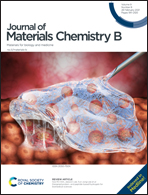A full-spectrum responsive B-TiO2@SiO2–HA nanotheranostic system for NIR-II photoacoustic imaging-guided cancer phototherapy†
Abstract
The second near-infrared (NIR-II) window (1000–1350 nm) usually offers further improved light penetration, a higher maximum permissible exposure (MPE), and a lower background signal. Development of NIR-II optical diagnosis and phototherapy technologies is of great significance for precise, efficient tumor therapy. In this work, a new type of Ti-based targeting agent (B-TiO2@SiO2–HA) nanotheranostic system with strong NIR-II absorption was designed and fabricated for the first time. Oxygen vacancies were formed in B-TiO2 and its band gap was narrowed, resulting in nanotheranostic systems with full-spectrum responses to stimulation with light. The experimental results showed that B-TiO2@SiO2–HA not only can enable high NIR-II photothermal conversion and provide excellent reactive oxygen species (ROS) production capacity, but also can enable high-resolution photoacoustic imaging (PAI) under NIR-II laser irradiation. Moreover, HA modification gives the nanotheranostic systems the useful ability to target high-CD44-expression tumor cells and tissues. In vitro and in vivo experiments demonstrated that B-TiO2@SiO2–HA exhibited a targeted photothermal/photodynamic (PTT/PDT) effect that produced tumor-cell ablation and apoptosis under the guidance of real-time NIR-II PA imaging. B-TiO2@SiO2–HA exhibits precise nanotheranostic potential for PAI-guided tumor-targeting phototherapy.



 Please wait while we load your content...
Please wait while we load your content...